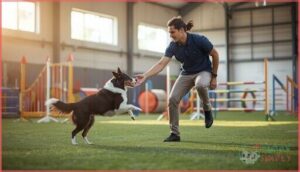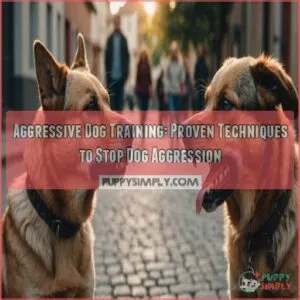This site is supported by our readers. We may earn a commission, at no cost to you, if you purchase through links.

Here’s what most dog owners miss: hyperactivity isn’t a personality flaw you need to accept. It’s often a puzzle with identifiable pieces, from genetics and boredom to hidden medical issues that keep your dog’s internal engine revving too high.
The good news? Once you understand what’s driving the behavior, you can use targeted training methods that actually work. Short, focused sessions paired with calming techniques can transform even the most frantic dog into a calmer, more manageable companion.
Table Of Contents
Key Takeaways
- Hyperactivity in dogs stems from identifiable causes like insufficient exercise, boredom, genetic predispositions, and sometimes underlying medical conditions that need ruling out through a veterinary checkup.
- Short, focused training sessions of about five minutes repeated throughout the day—combined with immediate rewards for calm behavior—prove more effective than lengthy training attempts.
- Calming techniques like massage, consistent routines, calming music, and dietary changes rich in tryptophan can reduce stress behaviors and hyperactivity by measurable percentages when applied consistently.
- Professional help from certified trainers or veterinary behaviorists becomes necessary when your efforts plateau, especially since 28-82% of behavioral cases involve underlying pain or medical issues you might miss.
Hyperactivity in Dogs
The chaos of canine hyperactivity affects roughly 12–15% of all dogs, but you don’t have to feel helpless. Your hyperactive dog’s constant movement and restlessness often stem from insufficient exercise and lack of reinforcement for calm behavior. This isn’t just about breed predispositions—environmental factors play a huge role too.
If your dog gets less than an hour of daily exercise or spends over eight hours alone, hyperactivity scores skyrocket. Medical causes like metabolic disorders can also trigger these behaviors, so ruling out pain or thyroid issues matters.
The behavioral impacts are real: owners report lower quality of life, and dogs struggle to settle even in quiet environments. Managing dog hyperactivity starts with understanding that canine hyperactivity is fixable with the right approach, patience, and consistency. True hyperkinesis may also present with attention deficit issues, which can further complicate training.
Training a Hyperactive Dog
Training hyperactive dogs works best when you keep sessions short—around five minutes—and repeat them throughout the day. Your timing matters: reward calm behavior immediately so your dog connects stillness with good things. Pair physical exercise with obedience drills or trick training to engage both body and mind. Routine consistency accelerates learning, so use the same cues every time.
For managing dog hyperactivity during walks, try a gentle leader leash for better control. Addressing the root causes, such as lack of routine can greatly improve behavior.
These focused training sessions build the foundation for lasting dog behavior modification without overwhelming your energetic companion.
Calming Down a Hyperactive Dog
Your dog’s making real progress through training, but calming techniques seal the deal. Think of it like teaching them to tap the brakes when their engine’s running hot. Managing hyperactive dogs means addressing their nervous system directly.
Try these proven calming strategies:
- Physical touch: Gentle massage lowers cortisol by 23% and helps anxious dogs settle faster
- Routine establishment: Set feeding and exercise schedules—it cuts stress behaviors by 32%
- Calming natural supplement: Melatonin or valerian root reduces anxiety in 60% of hyperactive dog cases
- Sensory management: White noise or classical music decreases reactivity by 45%
- Dietary changes: Tryptophan-rich foods boost relaxation in nearly half of dogs
- Calming devices: Pressure wraps reduce startle responses by 39%
- Medication trials: Your vet might suggest trazodone for situational calm
- Mental enrichment: Just 10-15 minutes of puzzle toys curbs excessive barking
Consistency turns these techniques into calm behavior patterns.
Additional Tips for Calming Hyper Dogs
Beyond basic training, several practical tools can accelerate your dog’s transformation. Calming music—especially classical or reggae—creates a calm home environment that reduces restlessness by up to 32%. Massage therapy delivers measurable results too, lowering stress hormones by 16% while building trust between you and your dog.
Here’s your action plan:
- Dietary changes: Switch to meals rich in tryptophan and remove artificial preservatives. About 46% of hyperactive dogs sleep better after simple diet adjustments.
- Mental stimulation: Rotate enrichment toys and puzzle toys weekly. Ten minutes of focused activity cuts problem behaviors by nearly two-thirds.
- Social interaction: Arrange playdates with calm dogs—they model relaxed behavior naturally, improving your dog’s stress scores by 27%.
- Calming natural supplement: Try melatonin or chamomile-based chews. Over half of treated dogs show noticeable improvement within 30 minutes.
Consistency transforms these additions into lasting calm.
Consider Professional Assistance
Sometimes, even with your best efforts, your hyperactive dog needs more help than you can provide on your own. That’s when turning to a professional can make all the difference in transforming your dog’s behavior.
Here are three professional options that can give you and your dog the support you need.
Hire Professional Trainer
Sometimes you need expert advice on dog training—and there’s no shame in that. A certified professional dog trainer or dog behaviorist can assess your dog’s unique triggers, design an individualized plan, and guide you through each step.
Look for trainer certifications from groups like the CCPDT or IACP, which signal serious credentials. Ask about their experience with hyperactive dogs and whether they use rewards-based methods.
Training costs usually run $75–$200 per hour, though board-and-train programs cost more. This investment in dog owner education pays off—professional guidance delivers real training effectiveness when you need it most.
Attend Training Classes
Group obedience training offers a proven pathway to better behavior. Over two-thirds of puppy owners attend at least one class by 16 weeks, and research shows structured training markedly reduces excessive barking and other problem behaviors. You’ll learn reward methods that work—owners using positive reinforcement report higher training effectiveness than those using mixed approaches.
Class accessibility varies, so explore options that fit your schedule:
- Multi-week programs generally run 4-6 sessions
- Group sizes cap around 10 dogs for individual attention
- Costs range from $15-$125 per session
Your dog gains essential socialization while you master techniques under professional guidance.
Consider Medication
When training and exercise alone don’t bring your hyperactive dog relief, medication safety becomes a conversation worth having with a veterinary behaviorist. After a thorough veterinary checkup rules out medical conditions, your vet can discuss drug efficacy for anxiety or hyperactivity. They’ll explain dosing trends, potential side effects, and whether supplements might help—tailoring treatment to your dog’s specific needs.
| Medication Type | Primary Use | Common Considerations |
|---|---|---|
| Fluoxetine (SSRI) | Severe hyperactivity, anxiety | 88% show improvement; 61% experience mild side effects |
| Gabapentin | Arousal, situational stress | 72% report behavioral gains; sedation possible at higher doses |
| Supplements | Mild anxiety support | Lower risk profile; effectiveness varies by individual |
Causes of Hyperactivity in Dogs
Understanding why your dog can’t seem to sit still is the first step toward helping them find balance. Hyperactivity doesn’t just happen out of nowhere—it stems from specific causes that you can identify and address.
Let’s look at the main reasons dogs develop hyperactive behaviors and what you can do about each one.
Causes of Hyperactivity
Before you can train your hyperactive dog, you need to understand what’s driving the behavior. Genetic Predisposition plays a role—breeds like Jack Russell Terriers and German Shepherds are hardwired for high energy. But it’s not just genetics:
- Environmental Factors like boredom and loneliness (especially over 8 hours alone daily)
- Early Socialization gaps that leave dogs anxious and overstimulated
- Medical Factors, including pain or underlying issues
- Household Factors such as inconsistent routines
Always start with a veterinary checkup to rule out medical conditions.
Calming Techniques
Once you’ve pinpointed the cause, it’s time to introduce calming techniques that teach your dog emotional regulation and self-regulation. These sensory techniques create a calm environment while reducing dog anxiety:
- Aromatherapy: Lavender or chamomile scents promote relaxation methods naturally.
- Canine Classical Music: Specifically composed to calm nervous systems.
- Calming Vest: Gentle pressure encourages calm behaviors through comfort.
- CBD Oil: Natural option for reducing hyperactivity when vet-approved.
- Mental Enrichment: Ten to fifteen minutes of puzzle work decreases restlessness markedly.
Breathing exercises—yes, for dogs—involve slow petting to sync their breathing rhythm with yours.
Professional Assistance
Sometimes professional guidance makes the advancement your best efforts can’t. A veterinary behaviorist can identify underlying medical issues—28% to 82% of behavioral cases involve pain—while creating a dog behavior modification program customized to your dog’s needs.
Certified trainers skilled in behavior therapy offer expert consultation on:
- Impulse control and desensitization techniques
- Environmental management strategies
- Daily exercise and enrichment schedules
Don’t hesitate to seek veterinary help when progress stalls.
Understanding Hyperactivity in Dogs
Now that you know what triggers the chaos, you need to understand what hyperactivity actually looks like in your dog. Here’s the truth: most dogs labeled “hyperactive” aren’t clinically hyperactive at all. Research shows only 4.2% of dogs meet strict ADHD-like criteria, yet 12-38% display hyperactivity symptoms depending on the setting.
Your hyper dog might struggle to stay still, bark excessively, or sleep less than eight hours daily. Young males and working breeds like Border Collies show the highest rates.
But here’s where understanding dogs gets tricky—hyperactivity differs from hyperarousal. Hyperactivity relates to breed differences and genetics, while hyperarousal means your dog’s stuck in a heightened, reactive state and can’t self-soothe.
Hyperactivity stems from breed and genetics, while hyperarousal means your dog can’t calm down from a reactive state
Recognizing these hyperarousal signs—the inability to calm down—helps you target the right solution for your hyperactive dog’s canine behavior.
Frequently Asked Questions (FAQs)
Are there any specific breeds of dogs that are more prone to hyperactivity?
Think of certain breeds as athletes born for marathons—they need constant motion. Border Collies, German Shepherds, Jack Russell Terriers, and Australian Shepherds are working breeds with genetic factors demanding intense exercise to manage their energy levels.
What diet changes help reduce dog hyperactivity?
Switching to natural ingredients and balanced nutrition helps manage your dog’s energy. Focus on carbohydrate management, protein moderation, and omega-3 supplements to reduce hyperactivity and support overall dog wellbeing.
How does age affect hyperactive dog behavior?
Puppies burst with boundless energy, while senior dogs slow down—yet hyperactive dog behavior shifts dramatically between these extremes.
Adolescent energy peaks around 6-24 months due to hormonal surges and neurological factors affecting impulse control and breed influences.
Can spaying or neutering calm hyperactive dogs?
Spaying or neutering won’t reliably calm your hyperactive dog. While it reduces hormone-driven behaviors like marking, studies show many dogs remain energetic afterward.
Hyperactivity often stems from breed, age, and training—not hormones alone.
Are certain toys better for hyper dogs?
Yes. Puzzle toys and scent games provide mental stimulation that exhausts hyperactive dogs faster than physical exercise alone. Durable chews and food puzzle toys redirect energy productively, promoting calmness through enrichment activities and cognitive work.
How do I exercise my dog indoors?
You can use indoor activities like puzzle toys, scent games, and interactive play to burn energy.
Dog treadmills and indoor agility exercises work well for high-energy dogs needing mental stimulation and physical exercise.
Conclusion
Think of your dog’s hyperactivity as a fire that needs the right fuel to burn steady instead of wild. You now have the blueprint: structured training, physical outlets, and calming techniques that tackle the underlying issue.
Learning how to train your hyperactive dog isn’t about crushing their spirit—it’s about channeling that energy into focus. Start small, stay consistent, and watch your chaotic companion transform into the balanced dog you’ve been searching for.
- https://pmc.ncbi.nlm.nih.gov/articles/PMC8147152/
- https://www.abvp.com/wp-content/uploads/2022/08/2022-09-5-Shelter-Behavioral-rehabilitation-of-extremely-fearful-dogs.pdf
- https://www.wisdompanel.com/en-us/blog/exercise-requirements-by-breed
- https://www.thetrustedcompanion.com/using-pavlovian-techniques-to-solve-common-behavioral-issues-in-dogs
- https://www.petdogtrainer.com/blog/classical-conditioning-and-its-use-with-dog-aggression











